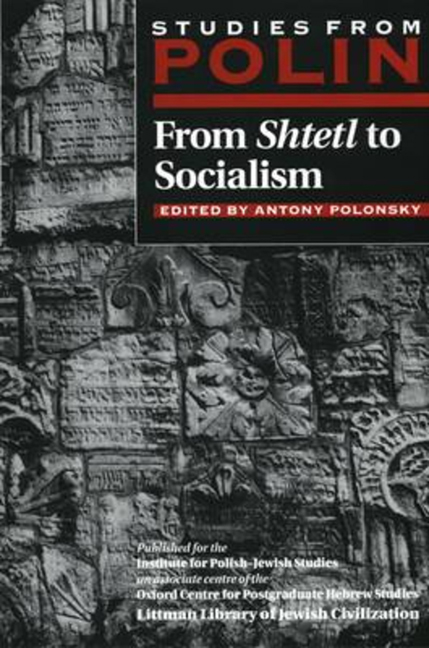Book contents
- Frontmatter
- Dedication
- Editors and Advisers
- Polin
- Polin: Studies in Polish Jewry
- Acknowledgements
- Contents
- List of Maps
- Introduction
- PART I PRE-PARTITION POLAND (to 1795)
- PART II THE NINETEENTH CENTURY
- 7 The Jews of Warsaw, Polish Society, and the Partitioning Powers, 1795-1861
- 8 The Jewish Community in the Political Life of Łódź in the Years 1865-1914
- 9 Aspects of the History of Warsaw as a Yiddish Literary Centre
- 10 Non-Jews and Gentile Society in East European Hebrew and Yiddish Literature 1856-1914
- 11 Trends in the Literary Perception of Jews in Modern Polish Fiction
- 12 Eros and Enlightenment: Love against Marriage in the East European Jewish Enlightenment
- 13 Gender Differentiation and Education of the Jewish Woman in Nineteenth-Century Eastern Europe
- 14 Polish Synagogues in the Nineteenth Century
- PART III BETWEEN THE TWO WORLD WARS
- PART IV THE SECOND WORLD WAR
- PART V AFTER 1945
- Notes on Contributors
- Chronological Table
- Maps
- Glossary
- Index
14 - Polish Synagogues in the Nineteenth Century
from PART II - THE NINETEENTH CENTURY
- Frontmatter
- Dedication
- Editors and Advisers
- Polin
- Polin: Studies in Polish Jewry
- Acknowledgements
- Contents
- List of Maps
- Introduction
- PART I PRE-PARTITION POLAND (to 1795)
- PART II THE NINETEENTH CENTURY
- 7 The Jews of Warsaw, Polish Society, and the Partitioning Powers, 1795-1861
- 8 The Jewish Community in the Political Life of Łódź in the Years 1865-1914
- 9 Aspects of the History of Warsaw as a Yiddish Literary Centre
- 10 Non-Jews and Gentile Society in East European Hebrew and Yiddish Literature 1856-1914
- 11 Trends in the Literary Perception of Jews in Modern Polish Fiction
- 12 Eros and Enlightenment: Love against Marriage in the East European Jewish Enlightenment
- 13 Gender Differentiation and Education of the Jewish Woman in Nineteenth-Century Eastern Europe
- 14 Polish Synagogues in the Nineteenth Century
- PART III BETWEEN THE TWO WORLD WARS
- PART IV THE SECOND WORLD WAR
- PART V AFTER 1945
- Notes on Contributors
- Chronological Table
- Maps
- Glossary
- Index
Summary
The fall of the Commonwealth of Poland and Lithuania and the partition of the state weakened the institutions which had kept the Polish Jews communally united. These had existed until the end of the eighteenth century despite the abolition of the Council of the Four Lands in 1764. New integrating factors emerged because of the changes in state dependence and the legal and economic position of the Jews, their relations with the Polish population and the administrations of the partitioning powers, as well as the emancipation processes and acquisition of real and formal equality, assumed different forms in the three areas of partitioned Poland. Of great relevance, as well, were the internal factors — Jewish attitudes toward inherited forms of communal organization and the distinctive features of this religious and cultural life. In the nineteenth century, processes developed which were already evident among the Polish Jews in the pre-partition period. Economic, social and cultural stratification accentuated. But it is chiefly religious divisions which are important to us here, since they affected how and why synagogues were built.
In the first half of the nineteenth century, mitnagdim, the followers of classical rabbinical Judaism, were largely recruited as members of the superintendence of synagogues. (This institution was introduced in the 1820s in the Congress Kingdom of Poland and Galicia, to replace the kehillah organization.) It was mitnagdim who were typically put in charge of communal property, which included synagogues, batei midrash (study houses), ritual baths and the like, and who made decisions concerning their management.
Hasidism grew in opposition to rabbinical Judaism. Originating in the eighteenth century in Podolia, during the nineteenth century it spread across Galicia, the Congress Kingdom of Poland and the Russian partition zone, becoming increasingly dynamic and popular among the Jewish masses. The religious life of the Hasidic Jews was centred around the homes of their spiritual leaders or tsaddiks. The hasidim did not normally take part in religious services held in the synagogue, and they prayed in their usually small shtibels, frequently located in private houses. Occasionally a few shtibels were situated in the same town, each one attracting the followers of a different tsaddik. Hasidim also erected their own large synagogues (for instance, dancer's synagogue in Lwów, the synagogues at Kowno, Sadagóra).
- Type
- Chapter
- Information
- From Shtetl to SocialismStudies from Polin, pp. 212 - 232Publisher: Liverpool University PressPrint publication year: 1993



